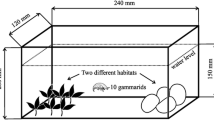Summary
Microhedyle milaschewitchii Kow. obtained from a sublittoral shellsand near Rovinj (Yugoslavia) prefers a grain size range of 0.5 to 2 mm in simple-choice experiments. This fraction predominates in the natural substrate (73.1%). Light did not affect the behaviour of the animals which are much less thigmotactical than Protodrilus. Sterile sands are rejected when offered together with natural substrate, but are equally attractive after having been incubated with sand bacteria for ten days. Similarly dried sand is not accepted by the animals. There is no significant preference between quartz and chalk sands, both containing bacteria. Optimal grain size and living microorganisms apparently are essential for the colonization of a substrate.
Zusammenfassung
Microhedyle milaschewitchii Kow. aus einem sublitoralen Schellsandvorkommen bei Rovinj (Jugoslawien) bevorzugte in Zweifachwahlversuchen eine Korngröße von 0,5–2 mm, die mit 73,1% im natürlichen Substrat vorherrscht. Die Tiere verhielten sich zum Licht neutral und zeigten im Vergleich zu Protodrilus keine extreme Thigmotaxis. Sterile Sande werden ebenso wie getrockneter Sand gegenüber natürlichem Substrat abgelehnt, sind aber nach zehntägiger Inkubation mit Sandbakterien diesem gleichwertig. Zwischen bakterienhaltigem Quarzsand und Kalksand zeigte sich keine signifikante Präferenz. Für die Besiedlung eines Substrates scheinen optimale Korngröße und lebende Mikroorganismen maßgebend zu sein.
Similar content being viewed by others
Literatur
Bergh, R.: Die Hedyliden, eine Familie der kladohepatischen Nudibranchien. Verh. zool. bot. Ges. Wien 45, 4–12 (1896).
Boaden, P. J. S.: Colonization of graded sand by an interstitial fauna. Cah. Biol. mar. 3, 245–248 (1962).
Boisseau, J. P.: Technique pour l'étude quantitative de la faune interstitielle des sables. C. R. Congr. Sav. Bordeaux 1957, 117–119 (1957).
Delamare-Deboutteville, C.: Biologie des eaux souterraines littorales et continentales. Vie et Milieu, Suppl. 9, 1–740 (1960).
Gray, J. S.: Selection of sands by Protodrilus symbioticus Giard. Veröff. Inst. Meeresforsch. Bremerh., Sonderbd. 2, 105–116 (1966a).
—: The attractive factor of intertidal sands to Protodrilus symbioticus Giard. J. mar. biol. Ass. U.K. 46, 627–645 (1966b).
—: Factors controlling the localisation of populations of Protodrilus symbioticus Giard. J. Anim. Ecol. 35, 435–442 (1966c).
—: Substrate selection by the archiannelid Protodrilus hypoleucus Armenante. J. exp. mar. Biol. Ecol. 1967, 1, 47–54 (1967a).
—: Substrate selection by the archiannelid Protodrilus rubropharyngeus. Helgoländ. wiss. Meeresunters. 15, 253–269 (1967b).
Hertling, H.: Über eine Hedylide von Helgoland. Wiss. Meresunters. Abtlg. Helgoland, N.F. 18, No 5, 1–10 (1930).
Jansson, B. O.: Salinity resistance and salinity tolerance of two oligochaetes, Aktedrilus monospermaticus Knöllner and Marionina praeclitellochaeta n.sp., from the interstitial fauna of marine sandy beaches. Oikos 13, 293–305 (1962).
Kowalevsky, A.: Les Hedylidés. Étude anatomique. Mém. Acad. Sci. St. Petersburg, Cl. Phys. Math. Sér. 8, vol. 12, No. 6, 1–32 (1901).
Marcus, E. u. E.: Über Philinoglossacea und Acochlidiacea. Kieler Meeresforsch. 10, 215–223 (1954).
——: Über Sand-Opisthobranchia. Kieler Meeresforsch. 11, 230–243 (1955).
Meadows, P. S. M.: Experiments on substrate selection by Corophium sp.: Films and bacteria on sand particles. J. exp. Biol. 41, 499–512 (1964).
Odhner, N. Hj.: Petits Opisthobranches peu connus de la côte méditerranéenne de France. Vie et Milieu 3, 136–147 (1952).
Salvini-Plawen, L. v.: Neue Formen im marinen Mesopsammon: Kamptozoa und Aculifera (nebst der für die Adria neuen Sandfauna). Ann. Naturhistor. Mus. Wien 72, 231–272 (1968).
Scheltema, R. S.: The effect of substrate on the length of planktonic existence in Nassarius obsoletus. Biol. Bull. 111, 312 (1956).
—: Metamorphosis of the veliger larvae of Nassarius obsoletus (Gastropoda) in response to bottom sediment. Biol. Bull. 120, 92–109 (1961).
Swedmark, B.: The interstitial fauna of marine sand. Biol. Rev. 39, 1–42 (1964).
—: Deux espèces nouvelles d' acochlidiacées (Mollusques opisthobranches) de la faune interstitielle marine. Cah. Biol. mar. 9, 175–186 (1968a).
Swedmark, B.: The biology of interstitial Mollusca. Symp. zool. Soc. London (1968) No 22 135–149 (1968b).
Wieser, W.: Factors influencing the choice of substrate in Cumella vulgaris Hart. Limnol. Oceanogr. 1, 274–285 (1956).
Author information
Authors and Affiliations
Rights and permissions
About this article
Cite this article
Hadl, G., Kothbauer, H., Peter, R. et al. Substratwahlversuche mit Microhedyle milaschewitchii Kowalevsky (Gastropoda, Opisthobranchia: Acochlidiacea). Oecologia 4, 74–82 (1970). https://doi.org/10.1007/BF00390614
Received:
Issue Date:
DOI: https://doi.org/10.1007/BF00390614




